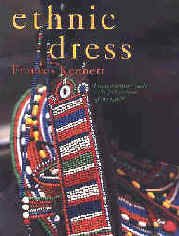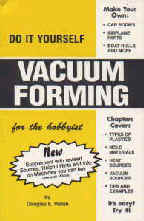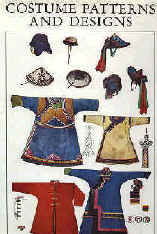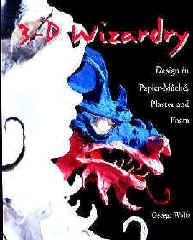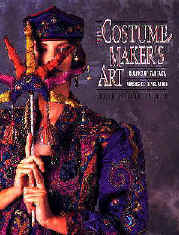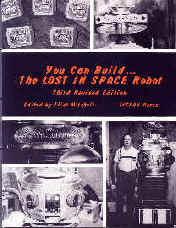|
|
Ethnic Dress by Frances Kennet, (with Caroline MacDonald-Haig)1995 Reed International Books, Limited (American Edition) ISBN# 0-8160-3136-3 192 pages |
| From the back of the book: "A comprehensive guide to ethnic dress throughout the world, illustrated with about 500 beautiful color pictures. From country to country, region to region, people's local dress is appraised and discussed in detail. Each chapter includes descriptive maps of the geographical regions and peoples. Also included are superb color details highlighting specific garments of the areas". 'Nuff said. | |
|
|
|
|
|
Do It Yourself
Vacuum Forming by Douglas E. Walsh 1990 Published by the Author $10(?) 135 pages
Though geared towards a model hobbyist, the instructions in this book can be used by costumers who have an interest in making their own lightweight, rigid plastic shapes for things like armor, etc. |
|
Vacuum-forming, for the
uninitiated, is used to make pieces of model airplanes, cars, etc. You
heat up a thin sheet of plastic until soft, stretch it over a form or
mold, then turn on a vacuum source to pull the plastic down tightly
over the mold and allow the plastic to cool in that position until
it's rigid again.
The books shows how to build vacu-form devices very inexpensively, showing how to construct them according to your budget -- from the very crude to the very sophisticated. The author takes you through all the steps in good detail, and also lists sources to buy everything you need. The copy we have is the 1996 edition - its sixth printing. He may have a website by now, we don't know. You can obtain the book from Flint Mitchell (see below), or you can contact the author directly at: Vacuum Form, 272 Morganhill Dr., Lake Orion, MI 48360 |
|
|
|
|
|
|
Costume
Patterns and Designs by Max Tilke 1990 Rizzoli International Publications, Inc. ISBN# 0-8478-1209-X 49 pages plus 128 plates This is, without a doubt, one of the handiest and most important books in our library. It's a terrific reference for examples of clothing worn through much of our history. While the illustrations are smallish on each color plate, there are lots of them and you get an idea of the design, patterns and the fabric used for each article of clothing. Examples range from Babylonian to approximately 19th century. |
|
Its strongest suit is the
ethnic clothing, which makes it an excellent source for seeing how a
piece hangs on a person, what it looks like when it's laid out flat,
and the decorations of said garment. It includes hats and other
accessories. Nora says that there are no new ideas when it comes to clothing designs, and this book bears her statement out. You still see these designs in modern clothing today. Needless to say, if you need inspiration or some form to base a costume on (and decorate the heck out of it), this is invaluable. |
|
|
|
|
|
|
3-D WIZARDRY -
Design in Papier-Mache, Plaster and Foam by George Wolfe 1995 Davis Publications, Inc. $23.95 ISBN# 0-87192-294-0 This is definitely a good book for making light-weight, reasonably inexpensive costume elements. |
|
When you look in
this book, it really inspires you to want to some of the techniques.
There are lots of photos, some in color. This is more aimed at
students of all ages, rather than the hobbyist, but the material is
useful to anyone. Given this, there are some great photos of examples
of what can be achieved with these (ostensibly) inexpensive materials
with large dollops of creativity. Subjects include marvelous masks,
huge dragons, puppets and free-standing sculptures as well. The one caveat is, when seeing the amazing things students featured in the book do, you realize you must have at least an inkling of sculptural design. While they can teach you the techniques, you have to have a good idea in mind of what you want to do. There are step by step instructions, a list of materials, and sketches to demonstrate each technique. For your own project, it then becomes merely a matter of adapting these methods to your needs. |
|
|
|
|
|
|
THE COSTUME-MAKER'S ART - Cloaks
of Fantasy, Masks of Revelation
1992 |
|
Every page is filled with wonderful color photos of people from all
over the U.S. and Canada in Historical, Fantasy, Science Fiction, and
wearable art creations. Two of our friends and SLCG members, Pierre and Sandy Pettinger, are featured inside. Our only regret is that we came to Costuming too late to be a part of this publication. We hope that someday there will be another edition or similar publication, to show how far the art has come since its printing. It is now out of print, but it can still be bought used from some costume book sites and it sometimes shows up on E-bay. If you want to truly be inspired, this is the book to have. |
|
|
|
|
|
|
YOU CAN BUILD...THE LOST IN SPACE ROBOT
Third Revised Edition, 1998 Flint is a gentleman I've known mostly by name only, but I see him at our regional SF convention called Archon, here in the St. Louis area. He has a dealer's table stocked with a rather eclectic mix of books, videos, figures, etc., of various subjects. |
| He is, from what
I've gathered, one of the most passionate fans of the old Lost In Space
TV series. Paging through this self-published manual, you can tell it is
a labor of love. The book is actually a collection of articles by people
who have built full scale replicas, along with additional material by
Flint. This includes a history of the robot and what happened to it
after the show was canceled. Almost every page has a clear,
well-detailed b & w photo illustrating each step of the process. It
also contains some great reference photos from the show and public
appearances of the robot. There are meticulous, detailed drawings and
photos for things like the control panels. Blueprints are also included,
to get those details looking just right. Some of the parts sources are manufactured by the contributors themselves, with a high degree of exacting standards. And if you just want a robot, but don't want to make one yourself, there's even an address for where you can buy a replica complete. There's useful information about plastic vacu-forming for some parts, as well as resin casting. Flint also includes a mini-catalog for all the resources you'll need for the unusual shapes to build the robot. |
|
| Previous | Back To Study |
